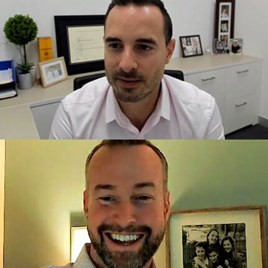May 01 2023 / Round the Table Magazine
Reversing the reluctance
Topics Covered
Even after an advisor has explicitly explained that long-term products with a lock-in period preserve liquidity so the value of an investment can appreciate, the prospect still might be stuck on having their money tied up for years.
The lock-in period is the most common objection that Aman Gupta, a one-year MDRT member from Mumbai, India, faces. Most prospects are not comfortable with parting from their funds, usually for five or 10 years for a unit-linked insurance plan (ULIP), when they can invest in mutual funds for the same period without restrictions on withdrawals or selling. So, for Gupta, providing even more articulate explanations about products is the key for tackling any objection.
When there is apprehension about the lock-in period, Gupta educates the client about the systemic withdrawal plan, which provides the option to withdraw money in installments rather than a lump sum. This approach establishes trust with the client whose objection has been provided with a solution from available plans, allowing him a five-year flexibility to withdraw through investment. Gupta also finds it helpful to inform the client about other flexible options such as switching between debt to equity and vice versa.
Winning over the seniors
Understanding why a prospect has an objection can help, as those reasons sometimes are connected to demographics and age group. For example, servicing senior citizens comes with its own set of challenges, since older prospects might not be comfortable purchasing plans with life insurance.
“These clients have a conservative approach to term insurance. They sometimes perceive the commission fee to be extraneous and do not want it to be part of the premium for the plan,” he said.
Many of his senior clients have adult children living abroad, and they need to be won over regarding the benefits that having coverage can bring.
“A lot of my foreign clients located in countries like Germany, United States and Canada are usually against taking on plans in India due to the perceived long processes, lines, wait times, etc.,” Gupta said. “However, on explaining the importance of the plan, the structured approach to follow, and how I as their financial advisor will see the process from end to end, most of these clients based abroad agree to take on life insurance and other tax saver schemes.”
Clients typically object to the insurance portion of the ULIP just because it has an insurance component. Why should they pay premiums when they can invest all their money in mutual funds or a fixed deposit bank account? Gupta understands that the benefits of the plan need to be explained in clear terms.
“I find it useful to explain the benefits of life coverage, and more importantly, the benefits of availing coverage for COVID-19 from the first day of the plan itself. It also helps if an added incentive for the plan can be offered to the prospective client that the cover for COVID-19 can be availed multiple times,” he said, adding that the advantage of tax-free maturity is also something that arouses the prospect’s interest.
Tailored solutions on the quick
Another way he handles objections is by providing a comparative analysis of plans to show the clients the differences between their options. This tactic was effective when working with high-net-worth (HNW) clients whom Gupta learned through experience that quick responsiveness, in addition to product knowledge, is what these clients seek most from an advisor. In one instance, he was pitching a unit linked insurance plan to a wealthy client who believed that a competitor’s offering was better because it allowed for switching between plans within a 10-day window. Gupta learned that this client was apprehensive about investing during a declining market. So, he countered by proposing a plan with a cheaper premium that was not bound by timeline. That flexibility would allow the client to switch multiple funds to get the best return.
“After seeing an 11% return, the client called me and was interested in purchasing another plan. Active services are necessary in financial advising,” Gupta said.
Understanding the needs of the demographic are essential to address issues whether it caters to the needs of senior citizens or dynamic services required for HNW clients. Gupta clearly understands the difference in approaches that were required to optimize his financial advisory skills.
“I have learned that client objections can vary with culture and even geography,” he said. “Client objections are a part of the process and can be overcome through product knowledge and a comparative analysis explaining the benefits of the plans offered. Also, clients with a high net worth tend to be more demanding and require quick service; these concerns can be addressed through efficient and prompt servicing.”
Shakunt Saumitra writes for Team Lewis, a communications agency assisting MDRT with content development for Asia-Pacific markets. Contact mdrteditorial@teamlewis.com.



![Elevating your financial advisory journey: how the right mentor can propel your success to new heights [Surabhi Chaudhary]](https://www.mdrt.org/globalassets/digizuite/32702-en-updated_-india_video-interview_surabhi-chaudhari-thumbnail.png?height=268&crop=0,0,268,268)

![Beyond finance: Individuals outside the financial profession every financial advisor should learn from [Nirmal Debnath]](https://www.mdrt.org/globalassets/digizuite/32634-en-india_written-interview_nirmal-debnath-thumbnail.jpeg?height=268&crop=0,0,268,268)
![How to tailor financial advice to fit the unique needs and goals of your clients [Merryl Baptista]](https://www.mdrt.org/globalassets/digizuite/32635-en-india_written-interview_merryl-baptista-thumbnail.jpeg?height=268&crop=0,0,268,268)
![Anticipating the financial needs of Gen Z clients and advising prospects towards adequate insurance cover [Komal Atal]](https://www.mdrt.org/globalassets/digizuite/32632-en-india_written-interview_komal-attal-thumbnail.jpeg?height=268&crop=0,0,268,268)
![Enhancing your offline persona through cultivating an online presence: Tips and strategies [Khushboo Bajaja More]](https://www.mdrt.org/globalassets/digizuite/32630-en-india_written-interview_khushboo-bajaj-more-thumbnail.jpeg?height=268&crop=0,0,268,268)
![A former flight attendant's sky-high client servicing standards [Beth Daffodil Uy Tan]](https://www.mdrt.org/globalassets/digizuite/32577-en-ph-_video-interview_a-former-flight-attendant's-sky-high-client-servicing-standards_daffodil-tan-thumbnail.png?height=268&crop=0,0,268,268)



![Overcoming a financial advisor’s internal self-doubts [Cedrick Cruz]](https://www.mdrt.org/globalassets/digizuite/32509-en-ph_written-interview_-handling-a-financial-advisors-self-doubts-cedrick-cruz-thumbnail.jpg?height=268&crop=0,0,268,268)